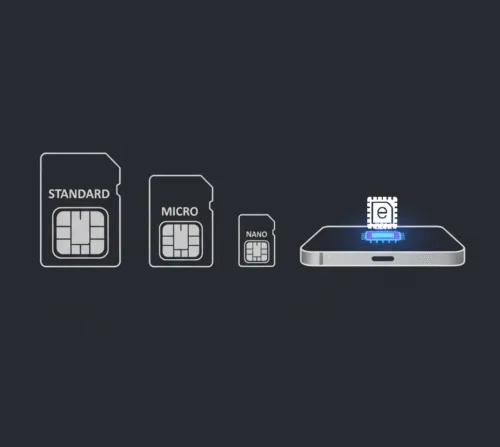
The Best Packing Cubes for Carry-On: Simple Guide for Travelers
November 5, 2025What is an eSIM? It’s a small change that makes a big difference in how we use our phones.
An eSIM is a digital version of the little plastic SIM card you’ve used for years. It does the same job, but it’s built into your phone instead of being something you can take out. You can connect to a mobile network, add data, or switch plans without touching any hardware.
Quick version:
An eSIM is a built-in SIM that you can activate with a QR code or an app. It’s easy, safe, and perfect for anyone who travels or switches plans often.
In this guide, you’ll learn what is eSIM how it works, and how to use it in everyday life.

From physical to embedded: See the evolution of SIM cards, culminating in the integrated technology that defines what is an eSIM.
What Is an eSIM?
The word eSIM means embedded SIM. It is a small chip that is already built into your phone, tablet, or smartwatch. Unlike a regular SIM card, you don’t need to insert or remove it.
When you activate an eSIM, your phone downloads a small digital file from your carrier. This file tells your phone which network to connect to. The process is quick and usually takes less than a minute.
If you have a recent smartphone, there’s a good chance it already supports eSIM. Many iPhones from the XS and XR onward have it. Most modern Android phones, such as Google Pixel and Samsung Galaxy models, also include eSIM support.
Most phones will have built in eSIMs, but check this list of eSIM-compatible phones to see if yours does.
eSIM vs Physical SIM
Let’s look at how eSIM compares to a regular SIM card.
| Feature | Physical SIM | eSIM |
|---|---|---|
| What it is | Small plastic card | Digital SIM built into your phone |
| Setup | Insert the card manually | Scan a QR code or use an app |
| Changing plans | Replace the card | Add or switch plans in settings |
| Space | Uses a slot in your phone | No slot needed |
| Best for | People who stay with one carrier | Travelers or users with multiple plans |
With a physical SIM, you often need to visit a store, wait for a new card, or carry extra ones while you travel. With an eSIM, you can handle everything from your phone. That makes it faster, cleaner, and easier.
Advantages of eSIMs
Disadvantages
How To Set Up an eSIM
Setting up an eSIM is simple. Here’s how to do it step by step.
-
Check your phone.
Make sure your device supports eSIM. You can find this in your phone’s settings or on the manufacturer’s website. -
Choose a provider.
You can buy an eSIM plan from your regular carrier or from a travel eSIM company. -
Get your QR code or activation link.
Most carriers will email or show you a QR code after you buy a plan. -
Add the plan to your phone.
-
iPhone activation, go to Settings > Cellular > Add eSIM and scan the QR code.
-
Android activation, go to Settings > Network & Internet > SIMs > Add eSIM and follow the instructions.
-
-
Turn on data and test it.
Once it’s active, check that your phone connects to the network and that data works properly.
If you ever want to switch or delete a plan, you can do it from the same settings menu. No tools or new cards needed.
Where To Buy an eSIM
You can get an eSIM from two main sources: mobile carriers and travel eSIM providers.
Local carriers
Most big carriers now support eSIM. For example, Vodafone, T-Mobile, AT&T, and Orange all let you use eSIM instead of a regular SIM card. You can ask for an eSIM profile when you start or renew a plan.
Travel eSIM providers
If you want data while abroad, travel eSIM providers are the easiest option. You can buy short-term plans for single countries, regions, or even global coverage. Many of these plans are prepaid and data-only, so you can use them without replacing your main number.
Here’s a simple comparison:
| Provider | Coverage | Starting Price | Highlight |
|---|---|---|---|
| Airalo | 190+ countries | From $4.50 | Easy app setup |
| Holafly | 160+ countries | From $19 | Unlimited data options |
| Strong eSIM | 180+ countries | From $1.90 | Flexible short plans Easy setup |
| Ubigi | 170+ countries | From $3 | Works well for tablets and cars |
You can compare data sizes, countries, and prices before you choose.
The Future of SIM Cards
The move to eSIM is already happening fast. Apple has released iPhones in the United States that use only eSIM. Many Android makers are following the same direction.
As more carriers support it, physical SIM cards will slowly fade out. The benefits are clear: instant setup, no waste, and smoother service for users everywhere.
Conclusion
Staying connected should be easy. eSIM makes that possible.
Instead of swapping cards or waiting in line, you can now activate mobile service with a quick scan or tap. It’s fast, practical, and ready when you are.

